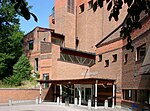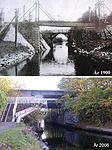Cosmonova
Cinemas in SwedenIMAX venuesPlanetaria

Cosmonova is an IMAX Dome cinema and planetarium located in an annex of the Swedish Museum of Natural History in Stockholm, Sweden. Cosmonova opened in 1993 and was the first ever dedicated IMAX installation in Sweden (and third in the Nordic countries after Tietomaa Science Centre in Oulu, Finland and Tycho Brahe Planetarium in Copenhagen, Denmark) and is also the largest planetarium in Sweden.
Excerpt from the Wikipedia article Cosmonova (License: CC BY-SA 3.0, Authors, Images).Cosmonova
Svante Arrhenius väg, Stockholm Norra Djurgården (Östermalms stadsdelsområde)
Geographical coordinates (GPS) Address External links Nearby Places Show on map
Geographical coordinates (GPS)
| Latitude | Longitude |
|---|---|
| N 59.3687 ° | E 18.0544 ° |
Address
Cosmonova
Svante Arrhenius väg
114 18 Stockholm, Norra Djurgården (Östermalms stadsdelsområde)
Sweden
Open on Google Maps









